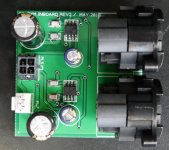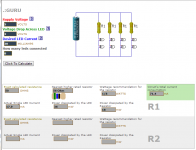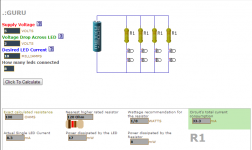Nick, Noob question again.
As Im using aftermarket RCA connectors on the back panel do they have to be insulated from common ground? My rear panel is aluminiun and will create a ground plane for all the ins/outs.
As Im using aftermarket RCA connectors on the back panel do they have to be insulated from common ground? My rear panel is aluminiun and will create a ground plane for all the ins/outs.
Hey, Jean Claude
Where can i get these fine in/out xlr-pcbs?
Thanks
You have a PM
Best regards
JC
Nick, Noob question again.
As Im using aftermarket RCA connectors on the back panel do they have to be insulated from common ground? My rear panel is aluminiun and will create a ground plane for all the ins/outs.
I would ALWAYS isolate connectors from the chassis as it would let you choose the best grounding scheme afterward.
An old analog man...
JC
Sounds promising.. 🙂I have several ideas for optimizing the processing, so it might be possible to implement this setup at 192 kHz in the future.
Hi,
I've now completed my Najda build :
full symetrical inputs/outputs
Amanero + isolator
+5 & +/-12 linear regulators
Now, it's time to go ahead in the real world...
Wow, looks great JC!
Paal
Wow, looks great JC!
Yes, that looks very nice indeed.
Thanks,
I listened to it quite extensively on my headphones (Senheiser HD580 / Westone 4) as a pass through 96 kHz (USB amanero input / sym output to a RME Fireface 400) and... I like the transparency. Next step will be on my three ways active system but for this I need a little more free time to make measurements and calculate adequate filters ! Hopefully later this month
JC
and a few details:
I too am extremely interested in those balanced i/o cards (and the other boards)
Can you give some circuit details please.
And let us know how they are connected to the najda board - from a previous photo it looks as though you've connected them to the back of the rca connectors. Is that right?
Thanks
Chris
Chris,
Nothing fancy here I followed the design sheet.
as I' decided not to touch the Najda board itself, I've just added input- output boards to the existing circuits. So yes, it is connected to the back of the RCA connectors because of its reversibility.
Due to the box I selected I had size constraint so 50 mm max for the 2 inputs board and 100 mm for each of the 4 output boards. (25 mm between each XLR)
I selected That Corporation IC 1200 serie for the input and 1646 for outputs for their good performances.
I added also RFI protection on inputs so I had to use CMS for that specific small board. Output board uses "normal" components.
To increase the input margin from 1V RMS to 2 VRMS, I selected 1206 chips (-6dB) but of course 1200 model (0 dB) could be soldered too.
here are the top and bottom of input board
Hope this helps
For the input board,
Nothing fancy here I followed the design sheet.
as I' decided not to touch the Najda board itself, I've just added input- output boards to the existing circuits. So yes, it is connected to the back of the RCA connectors because of its reversibility.
Due to the box I selected I had size constraint so 50 mm max for the 2 inputs board and 100 mm for each of the 4 output boards. (25 mm between each XLR)
I selected That Corporation IC 1200 serie for the input and 1646 for outputs for their good performances.
I added also RFI protection on inputs so I had to use CMS for that specific small board. Output board uses "normal" components.
To increase the input margin from 1V RMS to 2 VRMS, I selected 1206 chips (-6dB) but of course 1200 model (0 dB) could be soldered too.
here are the top and bottom of input board
Hope this helps
For the input board,
Attachments
Where do you buy the That Corp ICs?
Superfluous note: CMS (composant monté en surface ) = SMD (surface mount device)
I added also RFI protection on inputs so I had to use CMS for that specific small board. Output board uses "normal" components.
Superfluous note: CMS (composant monté en surface ) = SMD (surface mount device)
Where do you buy the That Corp ICs?
Hi Urban
Mouser seems to have the best choice but you can find a few ref at Farnell & RS Components
Superfluous note: CMS (composant monté en surface ) = SMD (surface mount device)
Oups ! Sorry
JC
Nick, this is what a web base calculator has come up with for the LED's.
74ma seems to be the current draw so it should be OK?
Which 5v supply would you recomend, the analogue I assume, pin 3 or 4?
74ma seems to be the current draw so it should be OK?
Which 5v supply would you recomend, the analogue I assume, pin 3 or 4?
Attachments
Last edited:
Take 5V digital supply. You can use any of Pin 8 on Expansion Port 0 or pin 28 on Expansion Port 1.
Best,
Nick
Best,
Nick
Nick, this is what a web base calculator has come up with for the LED's.
74ma seems to be the current draw so it should be OK?...
It surely depends on the LED used but 8 LEDs with 17,9mA each could sometimes be rather strong illumination in a decently dimmed room. Have you tested with the intended 8 LEDs in real life? Mike
New feature request:
I would like to be able to choose which channels are enabled for a particular setup. At the moment, all channels are always set to feed through a signal. But I would like to switch off specific channels. Specifically, I want to configure Najda to be a 2x3-way crossover in one setup (, 3, 5, 6, 7) and a feed-through DAC (using channels 4, 8) in another. Whichever preset I select, I want the other outputs to be muted.
I would like to be able to choose which channels are enabled for a particular setup. At the moment, all channels are always set to feed through a signal. But I would like to switch off specific channels. Specifically, I want to configure Najda to be a 2x3-way crossover in one setup (, 3, 5, 6, 7) and a feed-through DAC (using channels 4, 8) in another. Whichever preset I select, I want the other outputs to be muted.
Last edited:
Hi Shaun,
I'll look at enabling and disabling channels in the context of processing optimisation for those who use 192 kHz sampling rate in particular.
In the meantime, you can achieve your goal with custom biquads: for those channels that you want disabled, simply load one custom biquad with all coefs 0.
If you switch to FIR at some point, you can also get the same result by loading for each of the disabled channels an empty coef file (which is the default when creating a new setup).
Best,
Nick
I'll look at enabling and disabling channels in the context of processing optimisation for those who use 192 kHz sampling rate in particular.
In the meantime, you can achieve your goal with custom biquads: for those channels that you want disabled, simply load one custom biquad with all coefs 0.
If you switch to FIR at some point, you can also get the same result by loading for each of the disabled channels an empty coef file (which is the default when creating a new setup).
Best,
Nick
Thanks, Nick. Works a treat! I can now easily use Najda as a switch to compare my passive loudspeaker to my active speakers.
http://www.elipse.co.za/Docs/Biquad_Null.txt
http://www.elipse.co.za/Docs/FIR_Null.txt
http://www.elipse.co.za/Docs/Biquad_Null.txt
http://www.elipse.co.za/Docs/FIR_Null.txt
Hi Shaun
Same pair of speaker with either passive or active, or two sets ? I'd like to test my Tannoys with both XO but am not sure whether I should disconnect the passive XO while listening in active mode ? I have planned a manual switching board in case ...
Same pair of speaker with either passive or active, or two sets ? I'd like to test my Tannoys with both XO but am not sure whether I should disconnect the passive XO while listening in active mode ? I have planned a manual switching board in case ...
Hi all
10 Boards for a Group Buy in France by Melaudia have been ordered to Nick, mostly for very BIG multi-channel setups ! Will keep you informed on results (;-).
Jean-Louis
10 Boards for a Group Buy in France by Melaudia have been ordered to Nick, mostly for very BIG multi-channel setups ! Will keep you informed on results (;-).
Jean-Louis
@ JLOP:
I use Najda for my main loudspeakers (active, of course), but I also build passive loudspeakers, and then I sometimes like to listen to my second pair of speakers, Yamaha NS-1000s (also passive - for now ).
).
If you are comparing passive vs active versions of the same speaker configuration, I guess you should do it with a single speaker active and the other passive. Keeping the passive filter connected while trying to listen active is not workable, IMO.
I use Najda for my main loudspeakers (active, of course), but I also build passive loudspeakers, and then I sometimes like to listen to my second pair of speakers, Yamaha NS-1000s (also passive - for now
 ).
).If you are comparing passive vs active versions of the same speaker configuration, I guess you should do it with a single speaker active and the other passive. Keeping the passive filter connected while trying to listen active is not workable, IMO.
- Home
- Source & Line
- Digital Line Level
- DSP Xover project (part 2)



